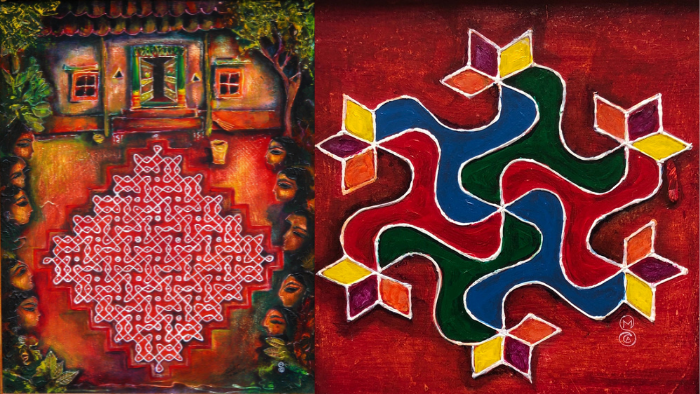Article by Smt Shanthi Chandrasekar
Scientists and mathematicians often talk about elegant equations or proofs that are simple yet profound, representing secrets of the universe, through their intrinsic beauty and various interpretations. Similarly, Kolams are ancient drawings with patterns that are aesthetically beautiful and mathematically inclined, while also representing deeper philosophies and life lessons.
Every morning at sunrise and sometimes at sunset, Indian women clear the ground in front of the house and draw a Kolam, a pattern of dots and lines using rice or rock powder. It is a symbol of welcome and seeks to bring good energy into the household. It is a tradition that continues to be performed as a daily ritual and has been handed down from generation to generation.
Kolams are drawn on the floor or directly on earth without the use of any measuring tools. The dots are drawn first in evenly spaced grids, and lines weave around them to create one or more closed loops or connect them to create abstract patterns or motifs like flowers, leaves, or conches. The drawings are walked over and only last a few hours before getting erased. On special occasions, Kolams are filled with colored powder or are drawn with a small piece of cotton cloth soaked in a paste made of rice ground with water, to make it last a little longer.
Traditional Kolam is an eco-friendly art form as it is created using natural materials like rice, rock, chalk or flowers. The rice powder serves as food for birds and insects, thus feeding a thousand souls leading to good Karma. What comes from Earth goes back to Earth and Kolams demonstrate this on a day-to-day basis. They remind us of the fragility of our world and the delicate balance between sustainability and overuse, making us aware of the interconnectedness of the entire system.

Kolams are steeped with philosophy and life lessons. The dots are said to represent challenges in life, and if one can weave their way around them and get back to the starting point, while still maintaining some kind of symmetry, they could deal with life’s ups and downs. Drawing a Kolam, whether it is on the ground or on paper, is like a form of Yoga, as it is a meditative process linking mind and body. There is a sense of calm as the grid of dots is drawn and the lines weave around them, going with the flow. Typically, the Kolam is drawn on the floor by bending at the hips, helping the body and mind stay flexible. It is a great way to begin the day with a combination of fresh air, exercise, and art.
Kolam captures the essence of the cosmos, a small portion of something much larger. The ephemeral nature of Kolams represents the cycle of creation and dissolution at various scales. They serve as a reminder of impermanence and non-attachment, teaching us to let go as complex beautiful patterns are drawn with the knowledge that it will fade away eventually. The play of entropy, from order to chaos, can be perceived in the short duration of a Kolam as its highly ordered patterns get disintegrated in just a few hours. While a grid of dots serves as the scaffold for the lines to weave around, they could symbolize matter and energy, or even the particle and wave nature of light. There is a striking resemblance between the Kolam designs and the patterns caused by vibrations of fine particles and fluids as demonstrated in Cymatics.
The Kolams are mathematical in their making and involve geometry at its core. The patterns are composed of six key shapes, which are formed by the permutations and combinations of a quarter of a circle and a quarter of a square. There are some implicit rules that Kolams tend to follow. Each of these six shapes can connect to other shapes at the nodes or the square corners. Four shapes always surround the square while the circle doesn’t connect with any other shape. By playing around with these possible connections, a number of different patterns can be created.

Kolams symbolize infinity as the closed loops can create never-ending paths with the line going around the dots following the shortest distance. These paths are similar to Euler’s circuits in which a path is traced only once. Kolams usually have at least one kind of symmetry - reflection, rotational, translational or scaling. Kolams can also be fractals as a simple pattern can be repeated to create larger and more complex Kolams while still retaining its original shape. Mathematicians are studying Kolams in connection with graph and knot theories and more.
Kolam practitioners draw these beautiful patterns every day without thinking of themselves as artists or mathematicians, but simply performing daily rituals, continuing their ancestors’ practice. It is a powerful idea to imagine all these women drawing everyday at about the same time, in front of their houses, focusing on their individual Kolams while simultaneously creating public art. The inherent beauty in the simplicity of dots and lines in Kolams along with its deep philosophy makes it a versatile tool to navigate through life. Though there are rules that guide the dots and lines, there is ample opportunity for endless creativity. Like the elegant equations and proofs, Kolams bring about a sense of fulfillment and contentment. Kolam is a culturally significant ritual that juxtaposes art, science and philosophy while also keeping an ancient tradition alive.




